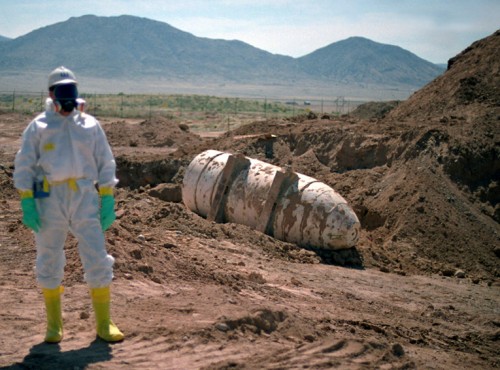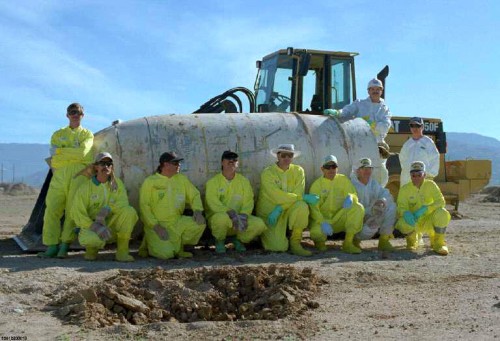During the 1950s, multi-megaton hydrogen bombs seemed like the difference between life and death to many — both supporters and opposers. The fate of the world seemed to hinge on weapons like the 15 megaton Mark 17 bomb, or the 7 megaton Mark 14, or the truly horrendous Tsar Bomba, and so on. And yet, even by the late 1960s, much less the MIRVed 1970s, these bloated weapons seemed both ridiculous from the standpoint of delivery and overkill.
The monster bombs of the 1950s were eventually superseded by smaller, more accurate, more numerous weapons. And the old bomb casings were dismantled and disposed of.
Flash forward to the end of the Cold War, and we get to one of my favorite nuclear photos of all time, one I jealously hoarded until I was able to use it in print. In 1998, Sandia National Laboratory was remediating a classified landfill (an idea I really enjoy — secret trash!) and they came across a casing of an old Mark 14 bomb. They did the sensible thing: they excavated it and took pictures of themselves posing with it, like it was an animal they had bagged on the hunt: 1
(I’ll note this is neither first time, nor probably the last time, that this blog will feature folks taking glamor shots weapons of mass destruction.)
The Sandia folks had the casing cleaned up (from a dirt perspective) and “sanitized” (from a classification perspective), and put it in an Air Force museum, apparently.
There is some deep poetry there: a post-Cold War look at the height of the Cold War, finding the rubbished H-bombs of yesteryear and turning them into elaborate trophies of a future generation.
- Source: Department of Energy Digital Photo Archive, photos #2011488 and #2010203.[↩]




Love it!!!!
Wow, all kinds of military waste is treated as a treasure. When will this arrive in the Air & Space Museum in DC?
Fabulous blog, Alex. Kudos.
[…] outdoor arrangement for your museum about war. And hey, let’s be honest: we’ve got quite a few of them left over from the Cold War. Might as well use them for […]
Livermore in 1954-1955 (7?) considered to test a Gnomon device that have a 1 gigaton yield ,probably at some fraction of its yield.
Data states that Mk17 as build ,with a natural Li-6 have a smaller yield than 19MT Mk36Y1.
Where data on 25Mt ?
Do you have any data on Lanl device named TAV (similar to Gnomon)?
GNOMON was meant to have a 10,000 Mt yield… totally nuts. Ah, my 25Mt was a typo — I meant 15 Mt. The US did have a 25 Mt weapon, the Mk-41. I haven’t seen anything on TAV, but I’ll keep an eye out.
….Thanks ! But,what about SUNDIAL?
I haven’t seen anything on it, other than a brief mention in Hansen’s Swords of Armageddon.
This is a SUNDIAL have a 10 GT yield,it was based on a largest ALARM CLOCK design.GNOMON have only a 1 GT yield, since it was a primary for a SUNDIAL.Murray mentioned it 23 Feb.1956 in the statement before JCAE.
I’m fairly certain that the museum still has it on display – http://maps.google.com/?ll=35.065192,-106.534714&spn=0.002999,0.00327&t=h&z=19&layer=c&cbll=35.065192,-106.534714&cbp=12,0,,0,0&photoid=po-61352197
Dang, my link does not work. Use the street view around the back of the museum and it should be apparent.